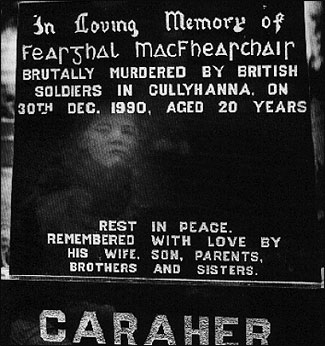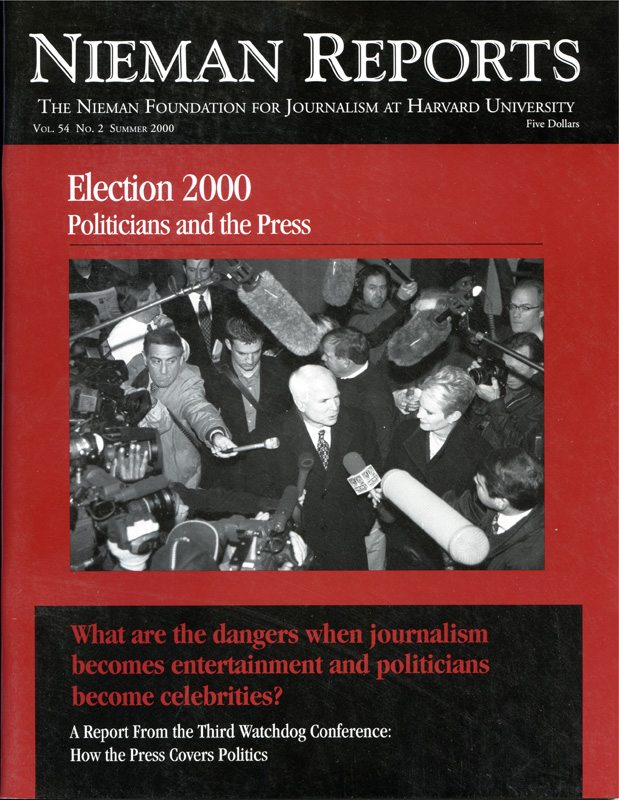
Brendan Caraher, four, visits his father’s grave in Crossmaglen, Northern Ireland. Photo by Stan Grossfeld, courtesy of Grossfeld/The Boston Globe.
Imagine, if you can, the following scenario happening in the United States. After more than a decade of censorship of radio and television coverage of a near-race war on the eastern seaboard, the union representing reporters in the electronic media finally summons the courage to challenge the federal government in the Supreme Court.
Instead of journalists celebrating this bid to restore freedom of speech, the reporter who doubles as the senior union official in CBS resigns in protest and angrily condemns his union leadership. No one in CBS or any other station raises a voice against him and, he becomes one of CBS’s top stars.
The rules say that the court case has to be taken in the name of an individual journalist, but despite an extensive trawling operation in the mainstream media the union is unable to find anyone to volunteer. Top-flight reporters in New York, Boston, Philadelphia, Washington, Chicago and Los Angeles are approached but each one says no. They are too frightened to take a stand. Finally someone agrees to put his name to the case, but this person is not a superstar with a face known to tens of millions. An unknown reporter for an obscure Spanish-speaking radio station in New Mexico carries the flag of press rights into battle instead.
In a country with as strong a First Amendment tradition as the United States, most journalists there would probably find it impossible to imagine such a thing happening in their own country or in any advanced Western democracy. Many would assume that events like those described above could only take place in some emerging democracy with no tradition of a free press.
They would be wrong, because this is exactly what happened in the civilized and supposedly democratic society of Ireland not very long ago. The reporter who resigned his office in the union, the National Union of Journalists (NUJ), worked for RTE, the state radio and television company, and he is now the station’s senior political correspondent. The man who eventually agreed to represent the NUJ in the challenge to our equivalent of the Supreme Court, the European Court for Human Rights, worked for a tiny Irish-speaking radio station in Galway, which is about as far away from Dublin and the center of the Irish media world as it is possible to go without getting your feet wet.
The NUJ lost its legal challenge in Europe, but events transpired to make their action redundant.
Thanks to the peace process in Northern Ireland the government in Dublin eventually dismantled the censorship laws in a move designed to edge the Provisional IRA and its political wing Sinn Fein into constitutional politics. Not long afterwards the British government abolished its own censorship regulations, and for the first time since 1976 coverage of events in Northern Ireland was officially untrammeled by state interference.
The Irish peace process has triggered a debate about the behavior of Britain and Ireland during the Troubles, particularly in regard to the way the actions of the police and military forces may have worsened the conflict. Debate on the role of the media has yet to start. Some might think that it is long overdue and, in particular, that reporters and editors should start to ponder whether acquiescence in the censorship of the Troubles only made the violence last longer.
Censorship has a long if not very honorable place in Irish history. The British imposed press controls during the 1919-21 war of independence, as did the pro-Treaty side in the subsequent Irish civil war. Newspapers were forbidden, for instance, to use words like “guerilla” to describe opponents of the new Irish government. Censorship lived on after the early Troubles. In the south of Ireland it took a less political and more religious form. The state censor was allowed to ban books and films on moral grounds, i.e. when they offended Catholic doctrine or values.
In Northern Ireland censorship remained entirely political. In the 1920’s the pro-British Unionist government passed the Special Powers Act, a draconian piece of legislation which gave the police the authority to ban any dubious expression of political thinking and to imprison those responsible.
Modern censorship in Ireland has its roots in the Northern conflict which erupted in 1970 and was to last for a quarter of a century. It was the government in Dublin that acted first. Alarmed by the rising violence and the widespread public acquiescence in the IRA’s activities and acting on the advice of Conor Cruise O’Brien, among others, it amended the Broadcasting Act in 1976 to control Irish radio and television coverage of the Troubles. Section 31, as it became known, made it an offense for any station to broadcast the spoken words of members of proscribed organizations, prime amongst them being, of course, the IRA and Sinn Fein.
The British were slower to act in such an open fashion. The early years of the conflict saw informal attempts to control coverage of the violence. In the BBC, for instance, every single program about Northern Ireland had to be vetted by top management before being aired. It wasn’t until 1988 that Margaret Thatcher’s government introduced regulations similar to those in the Irish Republic and censorship became formal.
There was very little resistance from the media to all this. Section 31 went unchallenged by Irish journalists. It wasn’t until 1988 that angry British journalists decided that Margaret Thatcher’s censorship law must be contested. Their resolution shamed their Irish colleagues into following suit. While the censorship laws did not legally apply to newspapers, they did in practice. The way that this worked could become a model for other conflict situations. Censorship of the electronic media helped create an atmosphere in which it became career-threateningly dangerous for any and all reporters to delve into certain areas. As a result, self-imposed censorship thrived.
Self censorship applied mostly to coverage of the IRA and Sinn Fein, but its impact was also observed with coverage of other subjects which members of the press should have been probing in depth such as allegations of serious miscarriages of justice. The Birmingham Six, the Guildford Four, and other innocent Irish people convicted of the most terrible bombings in Britain were eventually freed after commendable television investigations. Most of the evidence that set them free was available during their trials but 15 years were to pass before the media plucked up the courage to examine it.
When I started my life as a journalist working for Dublin newspapers the conventional view was that if you wanted to write about the Birmingham Six or Guildford Four that was tantamount to saying you were a fellow traveler of the IRA. It was the same if you wanted to write about the IRA. The reasoning was very simple and went like this: You had to be a fellow traveler because how else could you write about such people unless you talked to them like they were human beings and not the mindless monsters they undoubtedly were. And if you did that, then you must secretly sympathize with them. It was media McCarthyism Irish-style.
Not surprisingly, many journalists decided that in the interests of their careers and families it would be wiser to steer clear of such subjects. And so out of a limited form of state censorship there grew an all-embracing self censorship.
Supporters of censorship claim that it helped curb support for violent groups like the IRA.
Perhaps they are right, although I suspect that censorship, like Prohibition, only made the forbidden more alluring. There is a more important question: What impact did press censorship have on the search for a peaceful settlement of the Irish Troubles?
My view is that censorship probably extended the life of the Troubles by as much as a third and that people died unnecessarily because of it. I say this because what censorship did was prevent the media from explaining events fully. One result was that public and government understanding was less than it should have been. When, for instance, Sinn Fein, the IRA’s political wing, was successful in fighting elections in the early 1980’s, the full importance of this development was completely misunderstood. Uninformed and even misinformed about thinking inside Sinn Fein, the alarmed reaction of public and government alike was to intensify censorship by boycotting and isolating people like Gerry Adams.
The British and Irish governments now know, of course, that Sinn Fein was at that point starting out on a journey whose inevitable destination was the present peace process. They didn’t know it then because the media weren’t permitted to find out and tell them. The media weren’t able to tell them because most reporters never talked to Sinn Fein. They didn’t talk to Sinn Fein because they were terrified of the personal consequences.
Sinn Fein’s journey lasted nearly two decades. But how much quicker would it have been if people had been more fully informed about what was going on inside its ranks? How many more people would now be alive if nearly 20 years ago governments had realized they had a chance to show Sinn Fein that politics was preferable to violence?
Ed Moloney is the Northern Ireland Editor of the Dublin-based Sunday Tribune. Last year he was voted Irish Journalist of the Year. He has reported on Northern Ireland for 15 years.


